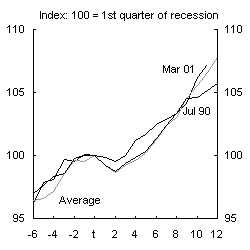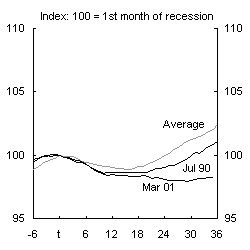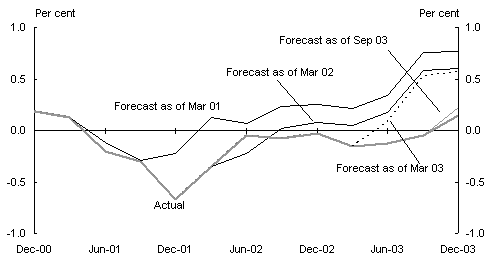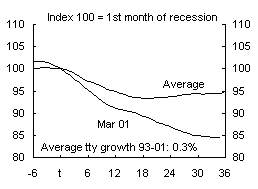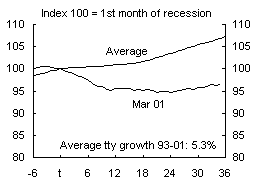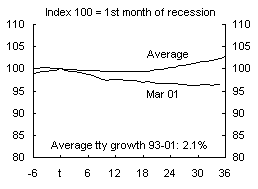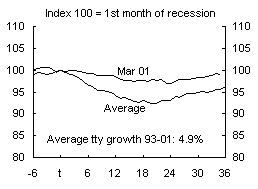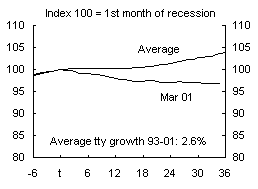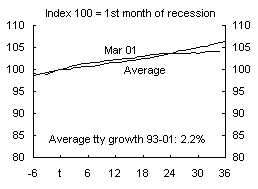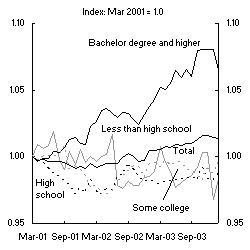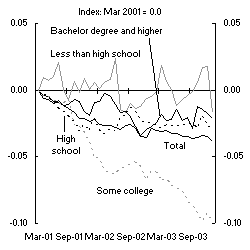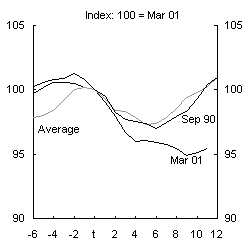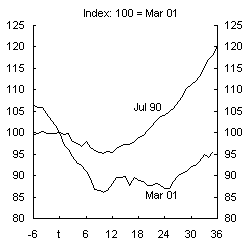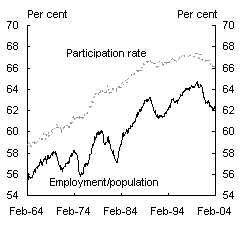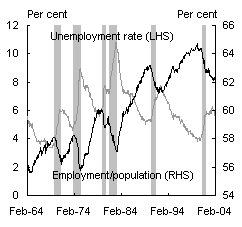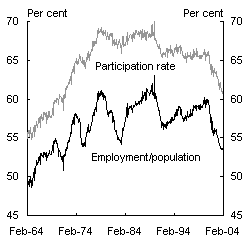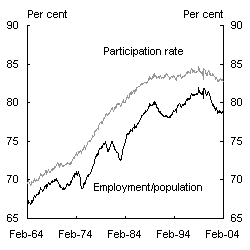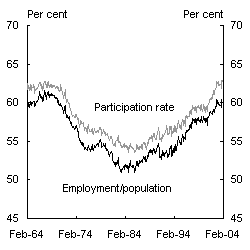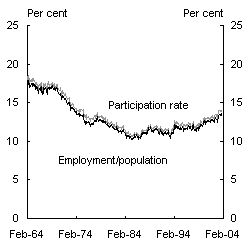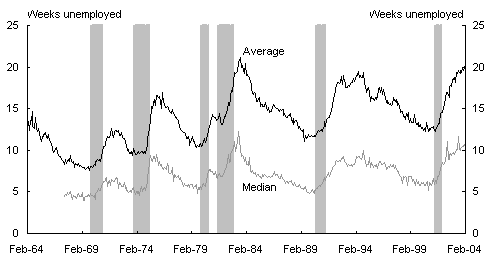Steven Kennedy and Jason Harris1
Continued labour market weakness presents a significant downside risk to the UnitedStates recovery. Given the reliance of the global recovery on sustained UnitedStates growth, developments in the UnitedStates labour market are a key element of the global outlook. This article examinesthe UnitedStates labour market, analysesthe composition of the demandand supply for labour, and discusses possible explanations of the weakness inemployment growth. Both cyclical and structural factors appear to explain the weakness.
The United States labour market has shed over 2.4 million jobs since March 2001, making this the weakest United States labour market performance since the Great Depression. The fall in employment is even more remarkable considering that the recession is one of the mildest on record in terms of output. However, a jobless recovery is not without precedent, with the 1991 recovery also known for generating relatively few jobs compared with previous recoveries. Regardless, the current employment recovery is far weaker and longer than the 1991 recovery, with employment declining by 1.8percent since March 2001, despite output growing by 7.3percent over the same period (Charts 1 and 2).2
|
Chart 1: Real GDP |
Chart 2: Non-farm employment |
|
|
|
The corollary of weak employment growth with robust output growth is strong labour productivity growth. As labour productivity is measured as a residual, an observed increase in productivity growth does not always imply a large step forward in the organisation of labour or technological change. For example, the increase in productivity may reflect cyclical responses to an overexpansion in the preceding period. Nonetheless, genuine ongoing productivity improvements would have the effect of raising potential output growth. In the medium term, this would allow stronger output growth, with less inflationary pressure, allowing monetary policy to remain relaxed for a longer period.
Employment demand
We estimated a simple labour demand function with which we could further examine the recent weakness in employment. The equation is specified to reflect labour demand generated by a profit maximising firm, with the short run or dynamic characteristics of employment captured by lags in the change in output. The estimated equation does a good job of explaining variations in employment and passes most relevant statistical tests.3
To examine the weakness of the United States labour market we conducted a series of experiments using our model of employment demand. We re-estimated the equation up to March 2001, and (dynamically) forecast employment growth using the known output and wage series. The equation was then re-estimated and new forecasts derived by sequentially adding additional employment data points. Selected forecasts of employment growth are presented in Chart 3. What these forecasts illustrate is that employment growth has been consistently weaker than that suggested by the historical relationship between employment, output and wages.
Chart 3: Forecasts of United States employment
(Quarterly growth)
Source: Australian Treasury, Bureau of Labor Statistics, Bureau of Economic Analysis.
Having demonstrated the extent of the recent weakness in employment growth through comparisons with previous recoveries and using an employment demand equation, we disaggregated employment by industry and educational attainment. This allows us to identify areas of strength and weakness in the United States economy, and to provide insights into possible explanations for the overall employment weakness.
Employment by industry
In Chart 4, we present indices of employment for six industries where each industry’s employment is indexed to 100 in the period each National Bureau of Economic Research’s (NBER) timed downturn occurs. The lighter line refers to the index of the most recent recovery while the darker line is the average of the previous six recoveries. In each chart we also show average through the year employment growth over the period January 1993 to February 2001, and the proportion of total employment in each industry as of 2003.
It is immediately apparent that manufacturing and professional and business services are the two industries where employment growth has been weakest compared both to previous recoveries and growth in the 1990s. We found that within both these industries, employment fell strongly in sectors engaged in Information and Communications Technology (ICT) related activities.
Within manufacturing, employment growth has been particularly weak in computer and electronic manufacturing, having fallen by 28percent since March 2001, accounting for around 20percent of the overall net fall in manufacturing employment, despite making up only 9percent of manufacturing employment. Other sectors within manufacturing that were particularly weak were transportation and fabricated metal production.
The sector of greatest weakness within professional and business services was computer systems design and related services, which fell by 18percent between March 2001 and December 2003. This sector accounted for around 41percent of the net fall in professional and business services employment, while making up only 7percent of the industry’s total employment. Another sector within professional and business services that experienced relative weakness was management services.
|
Chart 4: US industry employment growth |
||
|
Manufacturing (11.0% of employment) |
Professional and business services (12.4% of employment) |
Trade, transport and utilities (19.5% of employment) |
|
|
|
|
|
Construction (5.2% of employment) |
Information and finance activities (8.5% of employment) |
Other sectors (43.4% of employment) |
|
|
|
|
Source: Bureau of Labor Statistics.
A correction to an over-expansion of employment in industries that grew ahead of fundamentals in the late 1990s is one possible explanation of the current weakness in employment. The overall decline in employment in ICT related jobs, both in servicing aspects as well as their production, was dramatic.4 Employment in ICT industries, which makes up around 3percent of non farm employment, fell by around 1.2million since March2001.
Our analysis of industry employment suggests that cyclical aspects may have played an important role in the weakness of the labour market recovery. However, variations in industry employment might also reflect deep structural changes. Groshen and Potter (2003) explored structural changes in the United States economy by examining layoff trends and industry job gains and losses in the current recession. They found that the permanent relocation of workers from some industries to others may help explain the stalled growth in jobs. Industries that lost jobs during this recession have continued to shrink during the recovery, with permanent job losses eclipsing temporary layoffs, indicating structural changes. Comparing their measure of structural change to cyclical change, they find that the current cycle has a much larger incidence of structural change than previous cycles.
Structural job losses tend to take longer to recover than temporary losses, given the loss of human capital (that is, skills that are made obsolete), as well as the time required to find new positions in new industries. Furthermore, Figura (2003) finds that restructuring is not characterised by simultaneous permanent job losses in one industry and permanent job gains in another within the same region. The new jobs tend to come with a lag and in different geographical areas. Hence, the jobless recovery could be partly attributed to structural change underway in the United States economy.
The demand for skills
Aggregate demand for labour is comprised of demand for very different types of labour, and labour with different skills is sought across a range of industries. We examined employment growth by educational attainment to gain insights into changes in the quality of labour being sought.
In Chart 5, we present indices of recent employment growth by educational attainment groups. Note that these data are based on the United States household survey rather than the establishment survey, and that the overall change in employment is somewhat different between the surveys.5
The data in Chart 5 suggest that employment growth of the more highly educated has been quite strong. However, employment growth among these groups may reflect underlying growth in their population as the general population becomes on average more highly educated. To account in part for such an effect we subtracted average trend growth (calculated over the 1990s) from each series (Chart 6). This illustrates the weakness in employment growth in those with some college education but less than a bachelor’s degree compared with all other groups.
|
Chart 5: Employment by educational attainment |
Chart 6: Employment by educational attainment net of average 90s growth |
|
|
|
In a downturn we would expect that less productive workers would be more likely to lose their jobs than more productive workers. Examining the relative productivity of workers through educational attainment suggests that in this most recent downturn this has not been the case. Workers with more education (particularly those with some college education) have suffered relatively more than those with less education. This unusual outcome presumably reflects the weakness in employment in manufacturing and professional and business services, and suggests that industry composition is an important aspect of the most recent downturn.
We further examined changes in the demand for skills using a simple quality adjusted measure of labour input, using average industry wages to reflect relative productivity. The key conclusion was that the overall quality of the workforce fell during the downturn. This suggests that measures of labour productivity that do not take into account quality change (such as non-farm output per hour) may have underestimated the recent increase in productivity over the recent recovery.6
Wages
An aspect of the labour market that might lead to muted employment growth is high or increasing wages. The simple model of employment discussed earlier allows for growth in hourly wages and suggests that this is not a large part of the current employment weakness. There has been some argument that the increase in non-wage costs (for example, health insurance) has contributed to employment weakness, though the effect is likely to be relatively small.
Related to this aspect is the possibility that the relative price of labour compared to capital may have increased.7 Given the decline in the cost of new capital and the capital overhang built up during the late 1990s, there could be an element of substitution away from labour towards capital. This may explain some of the employment weakness as well as the increase in labour productivity.
Uncertainty, hours and temporary employment
It is possible that the unusual uncertainties that United States firms have faced during this recovery, in particular war and terrorism, have contributed to weak employment growth. This may have made firms reluctant to hire permanent staff. While a plausible partial explanation up to mid to late 2003, the continuing weakness of employment suggests that these effects are unlikely to be a major part of the story.
Furthermore, where there is strong current growth, but uncertain future growth, firms would tend to work their current employees longer, rather than hire new employees. Measures of hours worked have only increased marginally, despite 6percent annualised growth in output over the second half of 2003 (Chart 7). In a climate of uncertainty, firms might also choose to hire temporary rather than permanent workers. After a period of considerable weakness, there has been a recent increase in the hiring of temporary help, but this is off a very low base (Chart 8).8
|
Chart 7: Hours worked |
Chart 8: Temporary help employment |
|
|
|
Bernanke (2003) offers a further explanation of weak employment growth and large increases in productivity that involves the efficient use of new technology. He argues that a significant portion of the increase in productivity reflects managers reorganising production and distribution to take better advantage of their heavy investment in high-technology equipment in the late 1990s.
In contrast to the cyclical effects, this explanation, as well as Groshen and Potter’s explanation could result in ongoing strong productivity growth. If this is the case, the potential rate of output growth will have increased, with beneficial effects throughout the economy. However, it also implies that employment growth could remain weak for some period.9
Labour supply
The United States employment-population ratio has fallen from 64.3 to 62.2 per cent since March2001. This is one of the largest falls in the history of the series. Moreover, the ratio has continued to fall through the recovery period, unlike previous cycles where substantial falls have only occurred during recessions. While the fall in the employment population ratio is dramatic, there has also been a marked reduction in labour force participation, representing the largest fall in the history of the series (Chart 9).
The recent fall in labour force participation substantially offsets the fall in the employment-population ratio, such that the increase in the unemployment rate was relatively moderate. In past downturns, every percentage point fall in the employment population ratio would be accompanied by around a 1.6 percentage point increase in the unemployment rate. However, in this downturn, despite the employment-population ratio falling by 2.1 percentage points, the unemployment rate has only risen by 1.3percentage points — less than the ‘expected’ rise of 3.3percentagepoints (Chart 10).
|
Chart 9: Participation rate and employment-population ratio |
Chart 10: Unemployment rate and employment-population ratio |
|
Source: Bureau of Labor Statistics. |
Over-expansion in employment might b
e suggested by the historically high employment population ratios of the late 1990s. However, Bernanke (2003) argues cogently that if we ‘defined sustainable labor market conditions as an unemployment rate of 5percent and a labor force participation rate equal to its approximate trend value of 67percent, the level of aggregate employment would still be about 3 million jobs below the ‘sustainable’ level [in November 2003 when his speech was presented].’
Discouraged workers have been an important dimension of the current jobless recovery. In Chart 11, we show labour force participation rates and employment-population ratios for four age groups. For young people (aged 16 to 24years) the fall of 5.6 percentage points in the employment-population ratio since March 2001 has been almost matched by a fall of 5.0 percentage points in labour force participation.
|
Chart 11: Participation rate and employment-population ratio by age |
|
|
Age: 16-24 |
Age: 25-54 |
|
|
|
|
Age: 55-64 |
Age: 65+ |
|
|
|
The consequences of the fall in labour supply of young people may be relatively benign if these people are investing in more education. Data on high school and college enrolments support this hypothesis, with the proportion of 16-24 year olds enrolled in school increasing by 1.6percentage points from 2000 to 2002, after declining by 2percentagepoints over the period 1997 to 2000.
The majority of the fall in the aggregate employment-population ratio and labour force participation rate is due to persons aged 25 to 54 years. This age group accounts for around 70per cent of the population aged 16 years and over. The fall in participation for this age group is the largest on record, though admittedly this is off record highs in participation in the late 1990s. The withdrawal from the labour force by this age group, usually a group strongly attached to the labour force, is where the consequences of discouraged worker effects could be most profound. This group would also account for the vast majority of the increase in the unemployment rate and be over-represented in the duration of unemployment data.
Another interesting aspect of the labour supply data is the rise in participation of those aged 55 years and over. The sharp increase in participation of 55-64 year olds since the downturn in the broader economy may reflect the large falls in stock markets and the effects this had on retirement savings and wealth, though there has been an upward trend in participation for this age group for around two decades.
The duration of unemployment
An aspect of labour market downturns that can have hysteresis effects is the deskilling of individuals, usually reflecting the length of time spent unemployed. An examination of the median and mean duration of unemployment data suggests that this may become an aspect of the current recovery (Chart 12).
Chart 12: Duration of unemployment
Source: Bureau of Labor Statistics.
Currently the mean and median duration of unemployment are around their highest levels since 1983. Should the average duration of unemployment fall slowly, as was the case with the 1991 recovery, it is possible that a substantial body of labour force participants will be out of the workforce for a long period of time.
The increase in the duration of unemployment might reflect substantial structural adjustment within the United States economy. In this case, workers may have to retrain in order to find jobs in different industries, and this takes some time. Of course, an increasing duration of unemployment might also simply reflect widespread weakness in the demand for all labour.
Concluding remarks
The current United States recovery is notable for the significant weakness in the labour market, and without sustained employment growth the recovery may falter. Both cyclical and structural factors appear to explain the weakness in employment growth. Some of the structural factors imply strong ongoing productivity growth, while others imply only a once-off productivity ‘kick’.
In examining the supply and demand characteristics of labour, we have identified a number of areas of particular weakness. The demand for workers in ICT related sectors has fallen considerably, which is reflected in a fall in demand for relatively highly skilled employees. At the same time, the supply of younger workers has fallen considerably.
The unique circumstances around this recovery mean that models which are calibrated on past experience are less useful than they would otherwise be. The cyclical factors that we have discussed are not fully reflected in the cyclical movements in output and wages, resulting in a breakdown in traditional employment equations.
At least some of the factors underlying the labour market weakness appear to be structural. The nature of these structural factors
has significant implications for the UnitedStates economy, both in terms of the near-term labour market outlook and its effect on the output recovery, as well as to changes to the potential rate of growth.
If the labour market has been weak due to once-off structural adjustments, the rate of productivity growth should not continue indefinitely. As long as strong aggregate demand persists, we should observe an increase in employment in the near-term.
On the other hand, if there is an ongoing structural adjustment and strong economy-wide productivity growth continues, this could imply an increase in the potential growth rate. If this was the case, we could observe continued weakness in employment growth in the near term, even in the face of exceptional output growth. In the medium to longer term, higher productivity would result in higher potential output growth and stronger income growth with less inflationary pressure, allowing monetary policy to remain relaxed for a longer period.
References
Bernanke, B.S. (2003), Remarks at the Global Economic and Investment Outlook Conference, Carnegie Mellon University, Pittsburgh, Pennsylvania, Nov 4, 2003, http://federalreserve.gov/board/docs/speeches/2003/200311062.
Figura, A. (2003), The Effect of Restructuring on Unemployment, The Board of Governors of the Federal Reserve System, Finance and Economics Discussion Series, 2003-56.
Groshen, E.L., and Potter, S. (2003), Has Structural Change Contributed to a Jobless Recovery? Federal Reserve Bank of New York, Current Issues in Economics and Finance, Vol. 9, No. 8, pp. 1-7.
Scheft, S., and Singh, A. (2003), A Closer Look at Jobless Recoveries, Federal Reserve Bank of Kansas City, Economic Review, pp. 45-72.
Data appendix
US real gross domestic product data are sourced from the Bureau of Economic Analysis (BEA) National Income and Product Accounts (NIPA), Table 1.1.5 (Chart 1),
US non-farm payrolls data are sourced from the Bureau of Labor Statistics (BLS) Establishment survey (Equation 1, Charts 2 & 3).
US real non-farm gross domestic product data are sourced from the BEA NIPA, Table1.3.6 (Equation 1).
US real average hourly earnings are derived from (nominal) average hourly earnings data sourced from the BLS household survey, deflated by the Personal Consumption Expenditure deflator sourced from the BEA NIPA, Table 1.1.4 (Equation 1).
US employment by industry data are sourced from the Bureau of Labor Statistics (BLS) Establishment survey. The ICT related activities measure is derived by Australian Treasury. It include the following North American Industry Classification System 5 and 6 digit industries (with relevant supersector in parentheses): computer and electronic products (manufacturing); internet publishing and broadcasting, telecommunications, ISPs, search portals and data processing (information); computer systems design and related services (professional and business services) (Charts 4 & 8).
US employment by educational attainment data are sourced from the BLS household survey. The series presented in Chart 6 are detrended by Australian Treasury
(Charts 5 & 6).
US non-farm business hours data are sourced from the BLS Major sector productivity and costs index (Chart 7).
US participation rate and employment population data are sourced from the BLS household survey. The population, labour force and employment series for age groups 55-64 and 65+ were seasonally adjusted using X-11 by Australian Treasury (Charts 9, 10 & 11).
US unemployment rate data are sourced from the BLS household survey (Chart 10).
US high school and college enrolments for age group 16-24 are sourced from Table 2 of the BLS ‘College enrolment and work activity of 2002 high school graduates’ release.
US duration of unemployment data are sourced from the BLS household survey (Chart 12).
1 The authors are from the International Economy Division, Australian Government Treasury. We are grateful for comments and suggestions from David Gruen, Jim Thompson, PhilGarton, JyotiRahman and Martin Parkinson. The views in the article are those of the authors and are not necessarily those of the Australian Treasury. Data are current as at 26 March 2003. Since then, March 2004 employment data have been released, with payrolls increasing by 308,000 jobs.
2 The average recession is calculated using data from the six previous recessions since 1960 (1960, 1969, 1973, 1980, 1981 and 1990). Recessions are dated according to the National Bureau of Economic Research’s dating of the first month/quarter of recession. The recessions are indexed against the first month/quarter of recession, and then an average recession is calculated from these indices. Note that data are counted twice in the tail of the 1980 and head of the 1981 recessions.
3 Regression results are available from the authors on request.
4 The ICT related activities measure is derived by Treasury. It includes the following NorthAmerican Industry Classification System 5 and 6 digit industries (with relevant supersector in parentheses): computer and electronic products (manufacturing); internet publishing and broadcasting, telecommunications, ISPs, search portals and data processing (information); computer systems design and related services (professional and business services).
5 The United States household survey data indicates that employment growth has been slightly stronger, and hence productivity growth slightly weaker, than indicated in the establishment survey data. For a discussion of household versus establishment survey data see Bernanke (2003).
6 The method we used to derive a quality adjusted labour input (QALI) measure was less than ideal. In particular, the employment groupings were made across industries, rather than the preferred method of measuring quality through education, experience and age cohorts. Further details on the QALI measure are available from the authors on request.
7 The large net foreign capital inflow through the 1990s helped to push down the cost of capital.
8 Comparing the current labour market recovery to previous recoveries, Scheft and Singh (2003), conclude that the uptake of just in time employment practices has been a significant factor in the current employment weakness. Just in time employment practices involve greater use of temporary and part-time workers to achieve a more flexible labour force.
9 If the technology shock was a once-off, once the returns from the reorganisation are exhausted, there would be no increase in the potential rate of output growth.
